Welcome to the world of spiders in Canada. Most of the spiders you see in your home may be brown or black. There are plenty of colorful spiders around, though. These spiders are not just creepy crawlers but also part of nature’s fantastic art. In this article, we will learn about some of these colorful spiders crawling around Canada. We’ll talk about how they look, what they do, and more. So, forget your fear and get ready to explore the bright and exciting world of Canadian spiders!
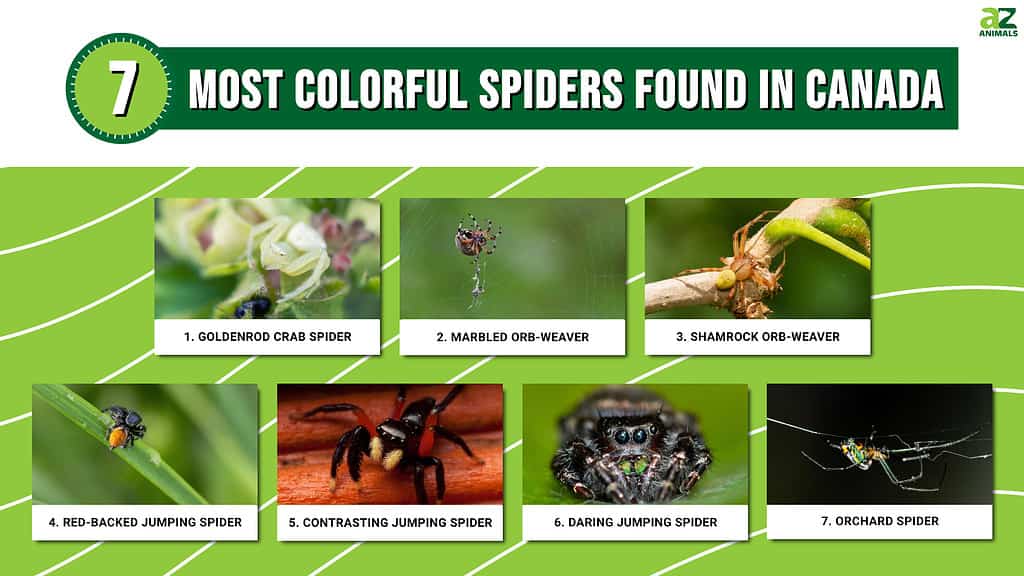
1. Goldenrod Crab Spider (Misumena vatia)
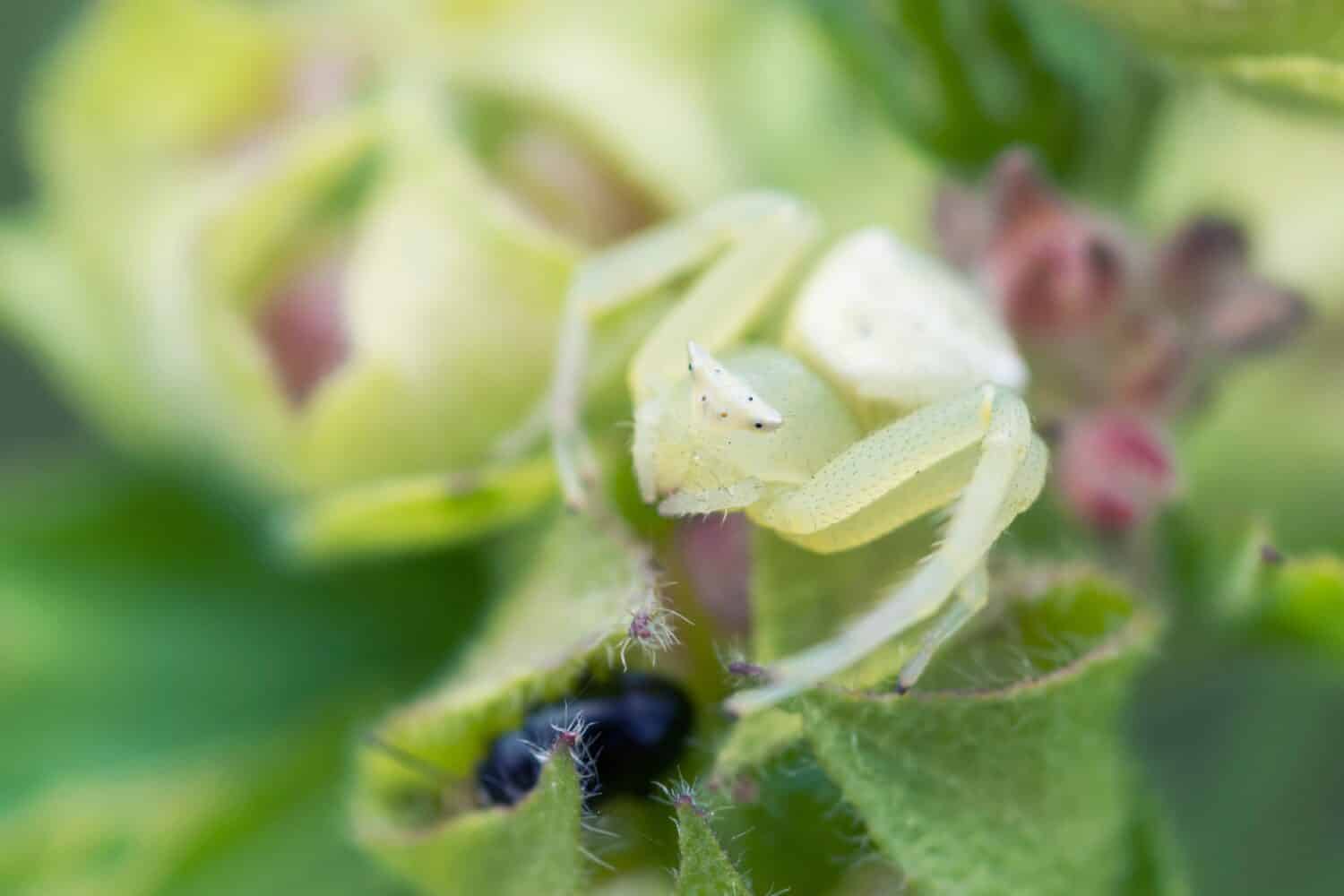
The goldenrod crab spider resembles a small crab with its pincer-like front legs.
©JossK/Shutterstock.com
One of the most colorful spiders in Canada, the goldenrod crab spider is a striking representation of nature’s artistry. Bearing a resemblance to small crabs due to their unique anatomy, this species has two front pairs of legs that are noticeably longer and laterally oriented, similar to a crab‘s pincers.
The coloration of the goldenrod crab spider serves a function beyond mere aesthetics; it’s also instrumental in their survival strategy. These spiders possess an extraordinary ability to alter their color based on their immediate environment. They can transition from a radiant, sunny yellow to an immaculate white, adapting to the hues of the flowers they occupy. This chameleon-like capability is critical to their hunting strategy, providing a camouflage that seamlessly blends into their surroundings.
The primary diet of this tiny spider comprises unsuspecting insects, including bees and butterflies, lured to the flowers the spiders occupy. Although most spiders we know spin webs to catch their prey, goldenrod crab spiders have a “sit-and-wait” strategy. They patiently bide their time, using their color-changing camouflage to ambush their prey.
This spider’s habitat choice is as versatile as its diet, ranging from meadows and gardens to woodland edges. However, these spiders display a particular affinity for areas abundant in goldenrods and daisies, where they can fully exploit their camouflage abilities.
2. Marbled Orb-Weaver (Araneus marmoreus)
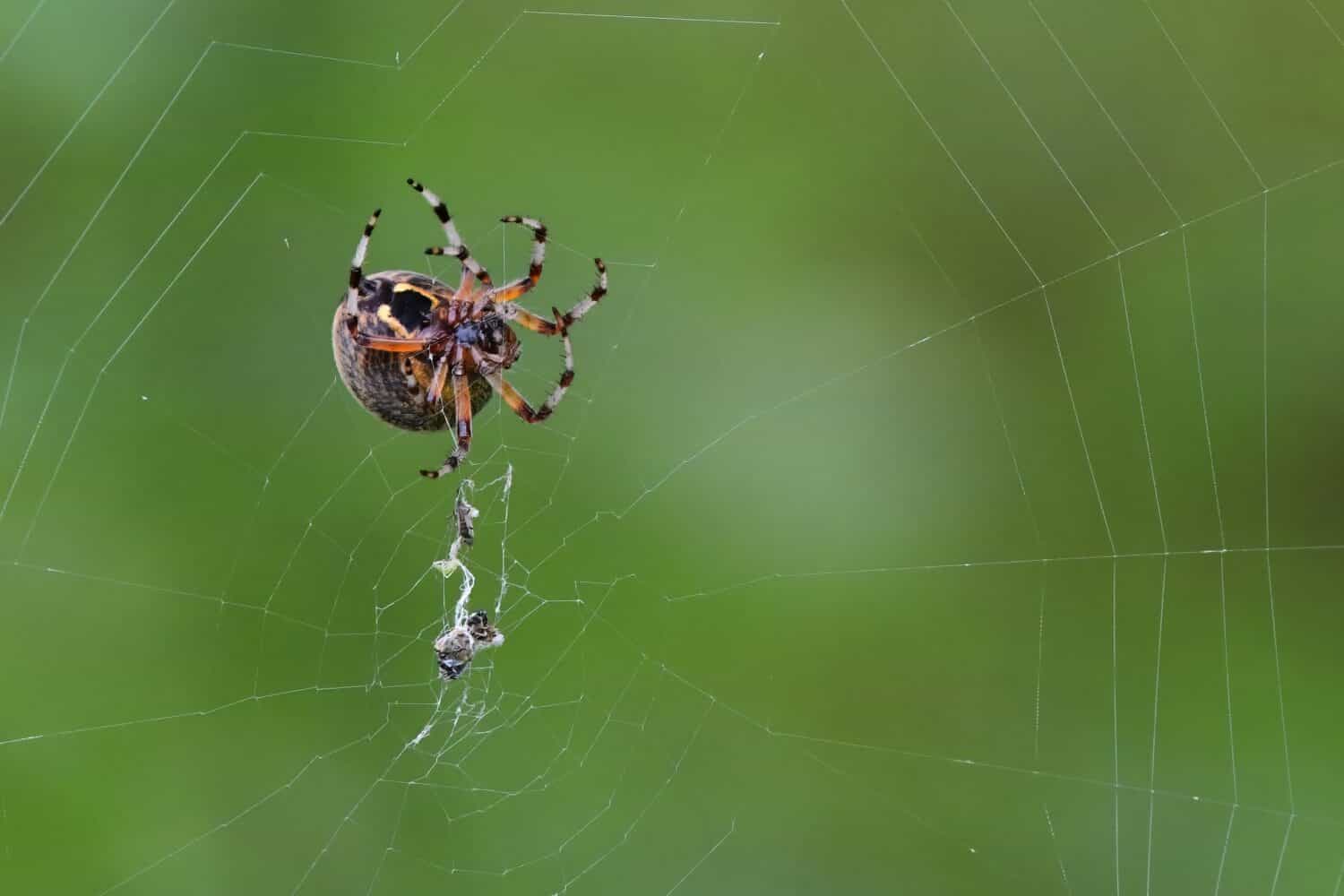
Intricate, marbled patterns adorn the abdomen of the marbled orb-weaver.
©JT Fisherman/Shutterstock.com
Another colorful spider in Canada is the marbled orb-weaver. It’s an attention-grabbing species with a decorated abdomen. That abdomen can be anywhere between a bright orange or yellow to a stark white. Its beauty doesn’t stop there; intricate, marbled patterns resembling abstract art adorn its abdomen (hence its name). These patterns consist of an intriguing fusion of black or dark brown lines, swirls, and blotches. In contrast to the vivid abdomen, the marbled orb-weaver’s legs and cephalothorax — the front part of the body, which includes the head and thorax — are usually a darker, more subdued brown in color.
When it comes to diet, the marbled orb-weaver is a formidable predator, primarily feeding on various small insects. They use large, vertical orb webs as strategic traps to catch their prey. The spiders commonly weave these webs, a masterpiece of biological engineering, amongst shrubs, tall plants, and the lower branches of trees. Interestingly, these spiders often rebuild their intricate webs daily, ensuring their tools of the hunt are always in prime condition.
The marbled orb-weaver showcases a high degree of adaptability when it comes to its choice of habitat. They flourish in various environments, from gardens and forests to meadows across Canada. Their preference, however, tends to lean toward areas with dense vegetation, where they can securely anchor their webs.
3. Shamrock Orb-Weaver (Araneus trifolium)

The colorful abdomen of a shamrock orb-weaver can be green, brown, or yellow.
©Paul Reeves Photography/Shutterstock.com
The shamrock orb-weaver has a distinctive and voluptuous abdomen. This dominant feature can exhibit various colors. In fact, its tones range from a subtle light green and earthy brown to yellow, making it one of the most colorful spiders in Canada. Adding a layer of complexity to this vibrant canvas are the patterns that adorn the body of this spider. These patterns are often of a fiery red or rich orange hue, outlined in stark white, creating a stark contrast that further accentuates the spider’s appearance. Their legs and cephalothorax are usually brown or gray in comparison.
The shamrock orb-weaver is an accomplished hunter, preying primarily on small, flying insects. They ingeniously trap their prey in their circular orb webs, a testament to their exceptional weaving skills. These webs are not merely traps but intricate works strategically placed in areas frequented by their targeted prey, ensuring a reliable and constant source of food. Like some other spiders, these spiders consume and rebuild their webs each day. This daily reconstruction is believed to enhance the stickiness of the web, thus ensuring optimum efficiency in prey capture.
Shamrock orb-weavers make their homes in various environments, from forests, gardens, and meadows. They are fond of areas teeming with dense vegetation and locations offering ample shade. These preferred conditions provide the ideal setting for securing large, ornate webs between plants, giving their distinctive hunting strategy an advantage.
4. Red-Backed Jumping Spider (Phidippus johnsoni)
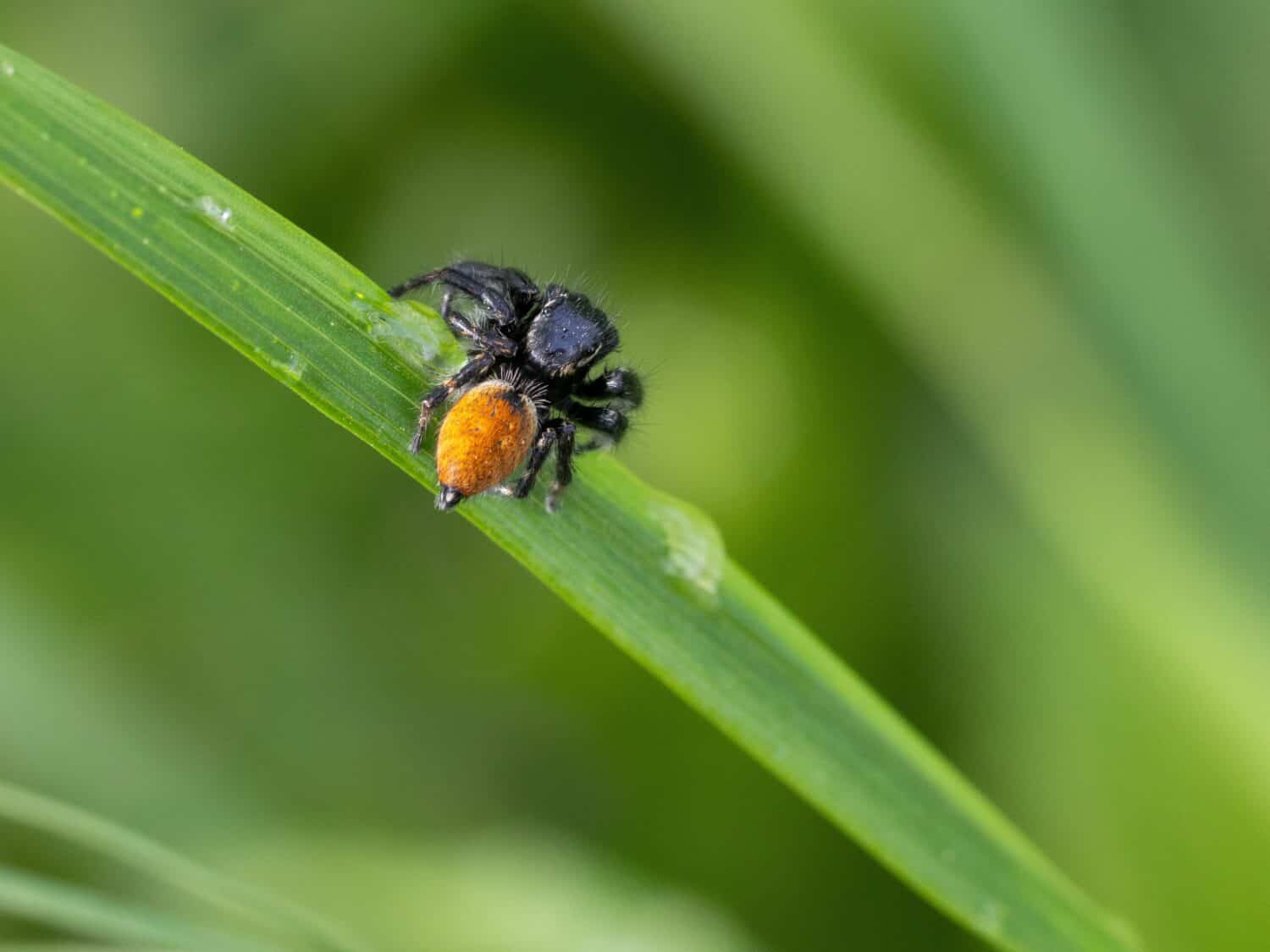
As one might expect, the colors on the red-backed jumping spider are particularly bold.
©Jordi Jornet/Shutterstock.com
The red-backed jumping spider boasts a bold color scheme that sets it apart, making it one of the most colorful spiders in Canada. The males, in particular, are recognizable with their intense, black bodies contrasted by a vibrant red or orange patch on their abdomen, which gives them their common name. This bright patch varies in size and sometimes covers the entire dorsal surface of the abdomen. On the other hand, females and juveniles display a more subdued coloration, often featuring shades of brown or gray with less pronounced red markings. Their eight eyes, a characteristic feature of jumping spiders, form a triangular pattern, with two large, forward-facing eyes.
Unlike many spider species that weave intricate webs to ensnare their prey, these spiders have a different, more proactive strategy. They are active hunters, stalking their prey with precision (thanks to their amazing eyesight) before executing a sudden, impressive leap to capture unsuspecting insects. This hunting technique is also the origin of their name. The red-backed jumping spider’s diet primarily consists of small insects, including aphids, caterpillars, and other spiders, thus playing a crucial role in maintaining the balance of their ecosystem.
These spiders are common in various environments, such as gardens and forests across Canada and the Western United States. They are especially prevalent in areas with plenty of sunlight, and they frequently cling to the walls of buildings, fences, or tree trunks as they bask in the sun. This preference for sunny spots can be attributed to their hunting behavior, as they rely on their excellent vision to detect and stalk their prey.
5. Contrasting Jumping Spider (Euophrys monadnock)
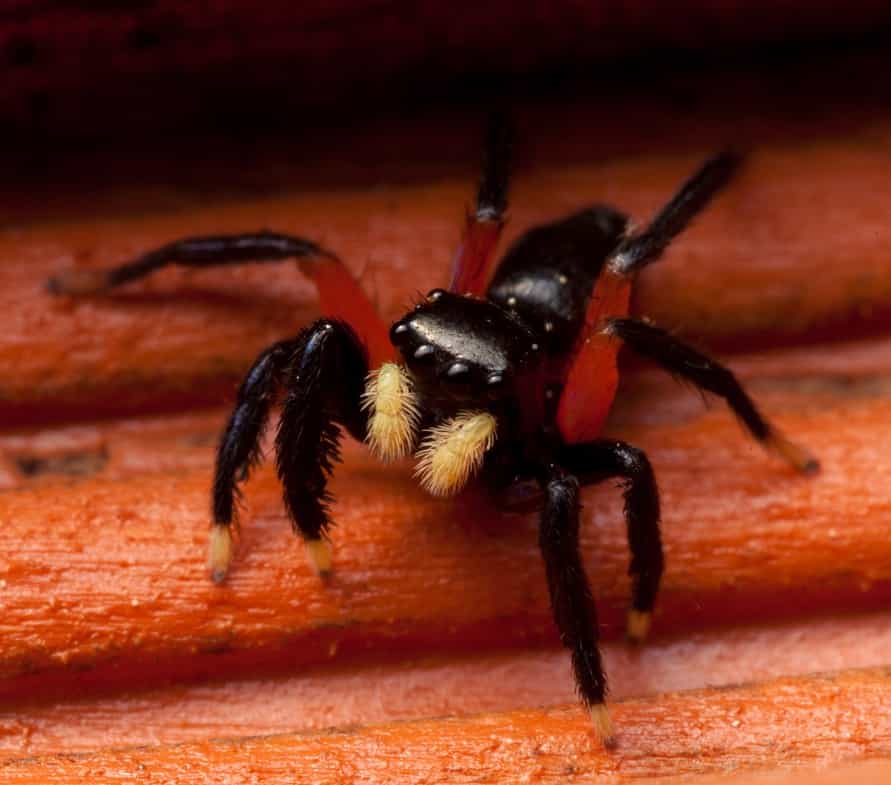
The eye configuration on contrasting jumping spiders is reminiscent of all jumping spiders.
©Marc Dufour/CC BY-SA 3.0 – License
Boasting a compact, robust body shape typical of many jumping spiders, the contrasting jumping spider’s unique color palette complements its aesthetics. What sets this species apart is the color of its legs. The legs of the Euophrys monadnock are often clothed in a bright red or orange hue. This display on their legs is particularly pronounced in males, contributing to their striking appearance. They also sport the trademark eye configuration of jumping spiders — a trio of eyes arranged in a discernible pattern, with two prominent, forward-facing eyes that give them their distinctive “jumping spider” look.
The diet of this jumping spider illustrates its hunting ability. Like most jumping spiders, these creatures diverge from the traditional, web-based hunting strategy that many of their arachnid counterparts employ; instead, this species adopts a more dynamic approach. As their name suggests, contrasting jumping spiders are active hunters, stalking their prey with a sense of precision and leaping to strike their targets when the time is right. Their primary diet consists of small insects and arthropods, including flies, beetles, and other spiders. Thus, they play a pivotal role in the local balance by keeping these populations in check.
You can find this species across various environments, but usually in forests and gardens. They often bask in the sun’s warmth on tree trunks, fences, or building walls.
6. Daring Jumping Spider (Phidippus audax)
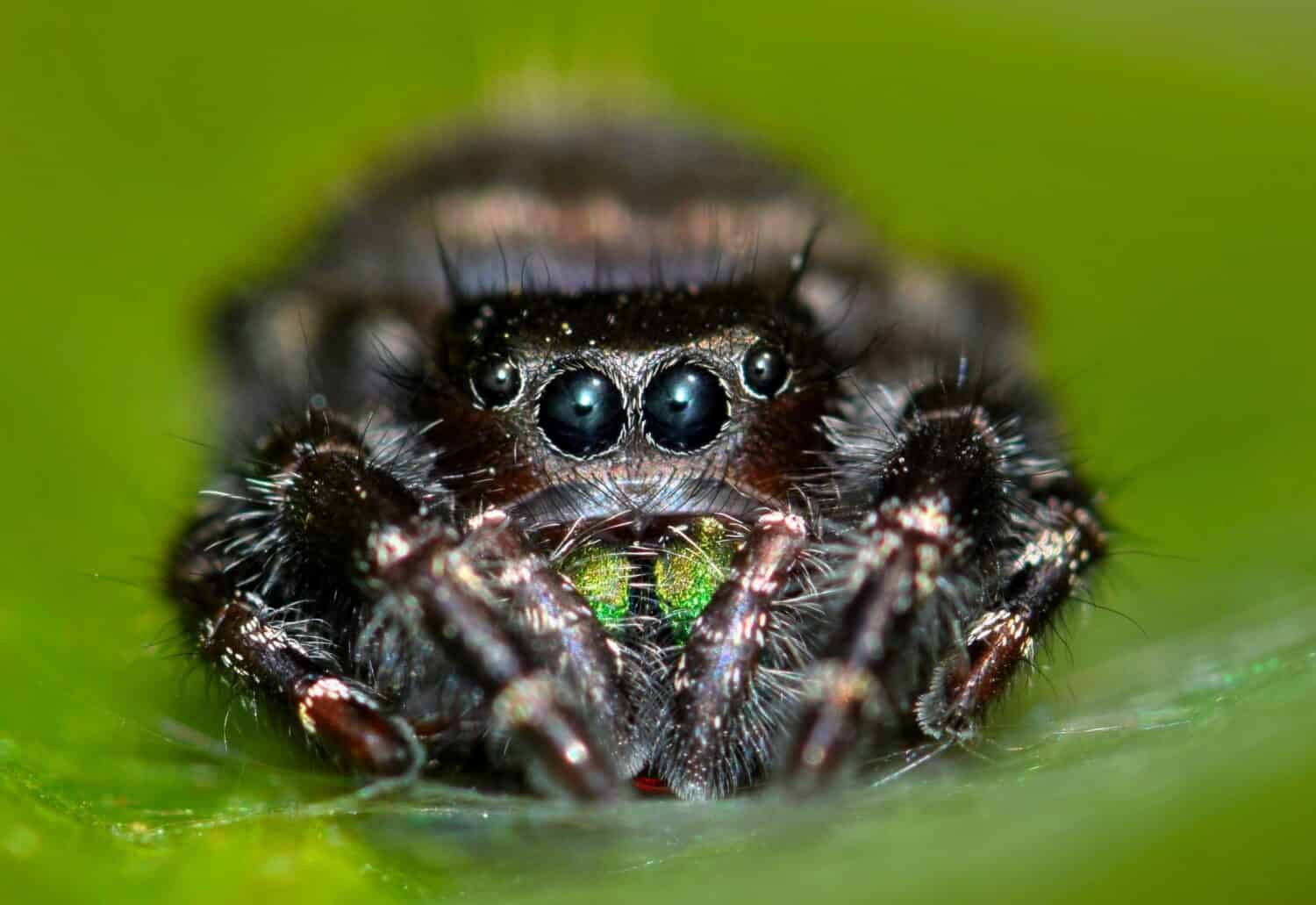
The body of a daring jumping spider is uniquely compact.
©Brett Hondow/Shutterstock.com
This intriguing arachnid has a distinctive visual appearance and behavior. With a compact, sturdy body shape, the daring jumping spider sports a predominantly black or dark gray coloration. However, the intricate, iridescent blue or green chelicerae (mouthparts) truly set this species apart, giving it with an otherworldly look. The males of this species, often more colorful than the females, also display bright white bands or spots on their abdomen. As a signature trait of jumping spiders, they possess large, forward-facing eyes.
The diet of the daring jumping spider offers a glimpse into its hunting lifestyle. They are active hunters who do not build webs, pursuing their prey with patience and precision. Their menu primarily consists of small insects such as flies, beetles, and other smaller spiders.
These spiders thrive in various environments, ranging from forests and fields to home gardens and human dwellings across Canada and the United States.
One interesting behavior of the daring jumping spider is its ability to perform intricate courtship displays. Male spiders engage in elaborate mating rituals to attract females. These displays often involve a combination of visual signals, such as raising and waving their front legs, vibrating their bodies, and performing rhythmic movements. These displays showcase the agility and agility of the male spider and serve to impress and court the female.
7. Orchard Spider (Leucauge venusta)
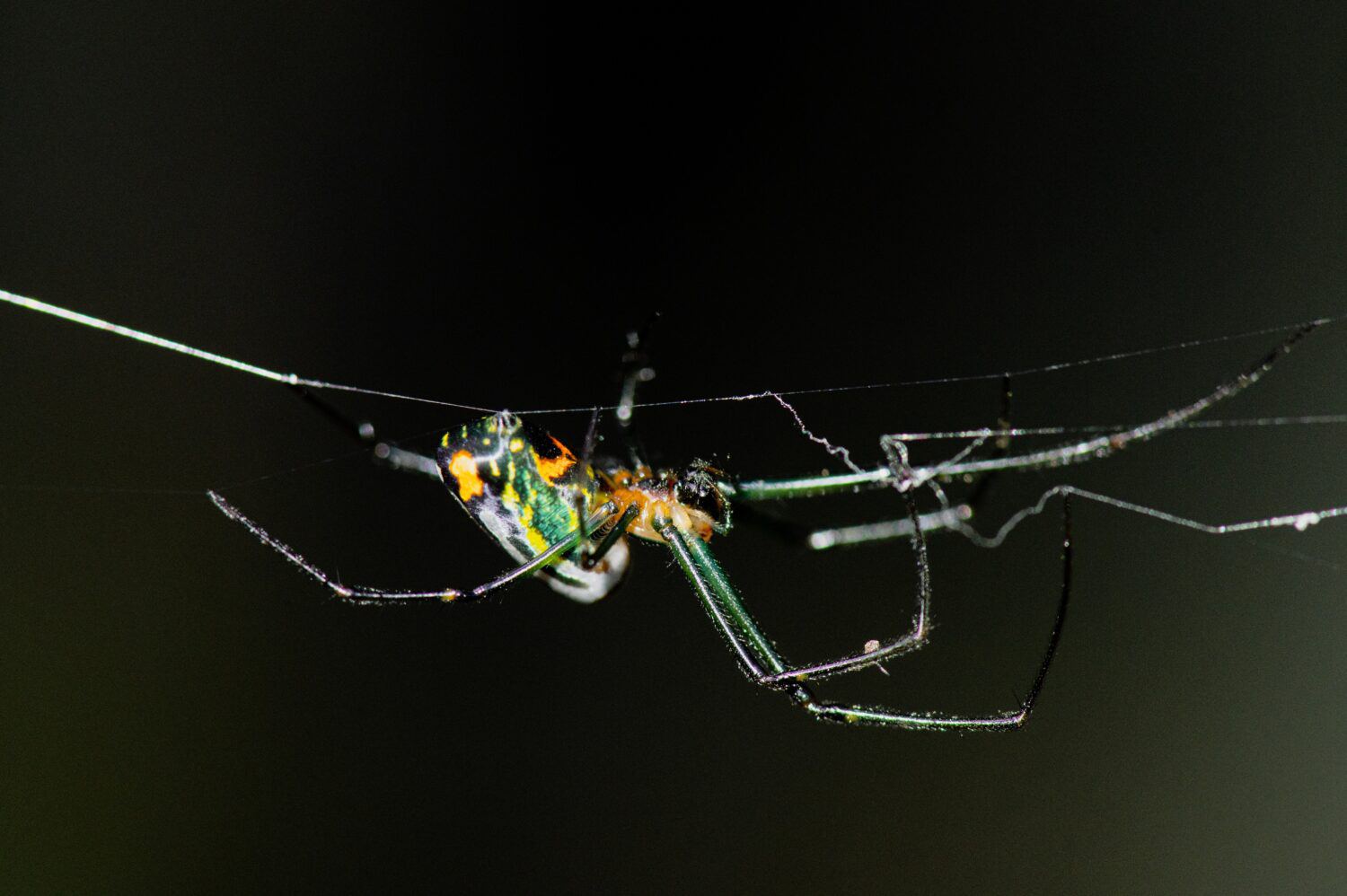
The abdomen of orchard spiders is typically very bright and colorful.
©Rogerio Peccioli/Shutterstock.com
The orchard spider has distinct physical attributes distinguishing it from many other species. Boasting a slender, elongated body, the female species are typically larger than their male counterparts. A silver carapace and a brightly patterned abdomen characterize this spider. The abdomen is triangular, adorned with elaborate green, yellow, silver, and black markings, with a pair of red or orange spots at the rear. The legs, long and spindly, are banded with black and yellow, adding to their vibrant appearance. Under different angles of light, the spider’s abdomen gives off a radiant, iridescent sheen, causing them to appear as if they are changing colors, earning the orchard spider the reputation of being one of the most colorful species of spiders in Canada.
Orchard spiders are primarily insectivores, with their diet consisting of small flying insects such as flies, mosquitoes, and tiny moths. Using a unique hunting strategy, the orchard spider spins a horizontal orb-shaped web, often in the vertical vegetation of meadows and forests, and waits for prey to fly into it. As the unsuspecting victim gets ensnared in the web, the orchard spider quickly subdues it by injecting venom and then proceeds to consume it.
In terms of habitat, orchard spiders are found in forested and garden areas, primarily in the Eastern and Central parts of North America. Their webs are often seen in the lower to mid-canopy layers, with these spiders displaying a preference for humid and temperate environments. This colorful spider contributes significantly to controlling insect populations within its ecological niche, making it a vital part of its local ecosystem.
Summary of 7 Most Colorful Spiders Found in Canada
Here’s a recap of the seven brightly colored spiders we took a look at that are present in Canada.
| Number | Spider | Scientific Name | Colors Present |
|---|---|---|---|
| 1 | Goldenrod Crab Spider | Misumena vatia | Yellow to white; color changes to match flowers they are on |
| 2 | Marbled Orb-Weaver | Araneus marmoreus | Orange, yellow, white, black, brown |
| 3 | Shamrock Orb-Weaver | Araneus trifolium | Light green, brown, yellow, red, orange, brown/gray |
| 4 | Red-Backed Jumping Spider | Phidippus johnsoni | Red, orange, black, brown/gray |
| 5 | Contrasting Jumping Spider | Euophrys monadnock | Red, orange, black |
| 6 | Daring Jumping Spider | Phidippus audax | Iridescent blue, green, black/dark gray, white |
| 7 | Orchard Spider | Leucauge venusta | Silver, green, yellow, black, red/orange |
The photo featured at the top of this post is © Rogerio Peccioli/Shutterstock.com
Thank you for reading! Have some feedback for us? Contact the AZ Animals editorial team.






